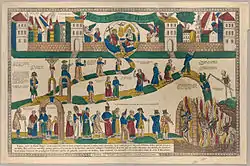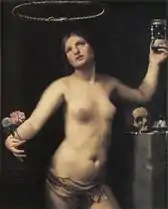Eternity
Eternity in common parlance means infinite time that never ends (or the quality, condition or fact of being eternal).[1] In classical philosophy, however, it is defined as what exists outside time as describing supranatural beings and forces, whereas sempiternity corresponds to the infinitely temporal, non-metaphoric definitions, as recited in requiem prayers for the dead. Thomas Hobbes and many others in the Age of Enlightenment drew on the classical distinction to put forward metaphysical hypotheses such as "eternity is a permanent Now".[2]
Eternity as infinite duration is an important concept in many religions, where the god or gods are said to endure eternally. Some, such as Aristotle, would say the same about the natural cosmos in regard to both past and future eternal duration, and like the eternal Platonic forms, immutability was considered essential.[3] Today cosmologists, philosophers, and others look to analyses of the concept from across cultures and history. They debate, among other things, whether an absolute concept of eternity has real application such for the fundamental laws of physics such as the arrow of time in entropy.
Philosophy
Aristotle argued that the cosmos has no beginning. In Aristotle's Metaphysics, eternity is the unmoved mover (God), understood as the gradient of total synergy ("produces motion by being loved").[4] Boethius defined eternity as "simultaneously full and perfect possession of interminable life".[5]
Symbolism
Eternity is often symbolized by the endless snake, swallowing its own tail, the ouroboros (or oroboros). The circle, band or ring is also commonly used as a symbol for eternity, as is the mathematical symbol of infinity, . Symbolically these are reminders that eternity has no beginning/end.
 The Ouroboros
The Ouroboros The "endless knot," a symbol of eternity used in Tibetan Buddhism
The "endless knot," a symbol of eternity used in Tibetan Buddhism Infinity symbol variations
Infinity symbol variations Folk-art allegorical map "The 3 Roads to Eternity" from Matthew 7:13-14 by the woodcutter Georgin François in 1825.
Folk-art allegorical map "The 3 Roads to Eternity" from Matthew 7:13-14 by the woodcutter Georgin François in 1825. An allegorical classical woman c.1670s, representing eternity. She holds up an hourglass, her elbow above a human skull and in her lower hand two flowers in maturity, one of which is a dandelion blowball or clock (seed head), reminders of transience. An Ouroboros, snake swallowing its own tail, floats above her head as a halo - symbols of eternity.
An allegorical classical woman c.1670s, representing eternity. She holds up an hourglass, her elbow above a human skull and in her lower hand two flowers in maturity, one of which is a dandelion blowball or clock (seed head), reminders of transience. An Ouroboros, snake swallowing its own tail, floats above her head as a halo - symbols of eternity.
See also
References
- "eternity, n." 1. and 2. OED Online. September 2019. Oxford University Press. https://www.oed.com/view/Entry/64704 (accessed October 26, 2019).
- Mr. Hobbes Considered in his Loyalty, Religion, Reputation, and Manners. By way of Letter to Dr. Wallis (English autobiography) T. Hobbes, 1662 at p.50
- "Stanford Encyclopedia of Philosophy, Eternity". Plato.stanford.edu. Retrieved June 13, 2016.
- Yu, Jiyuan The Structure of Being in Aristotle’s Metaphysics Springer, 2003, p. 188
- Boedder, Bernard. "Natural Theology". University of Notre Dame. Archived from the original on March 4, 2016. Retrieved March 15, 2015.
Aeternitas est interminablis vitae tota simul et perfecta possessio
External links
| Look up eternity in Wiktionary, the free dictionary. |
| Wikiquote has quotations related to: Eternity |
| Wikimedia Commons has media related to Eternity. |
- http://plato.stanford.edu/entries/eternity/ Entry in the Stanford Encyclopedia of Philosophy on Eternity.
- http://www.iep.utm.edu/g/god-time.htm Entry in the Internet Encyclopedia of Philosophy on the relationship between God and Time.

